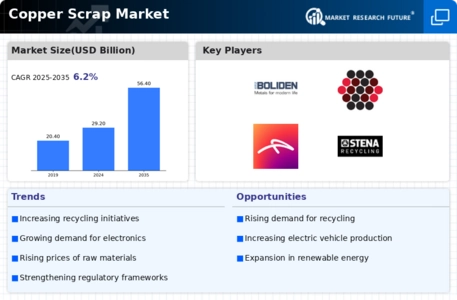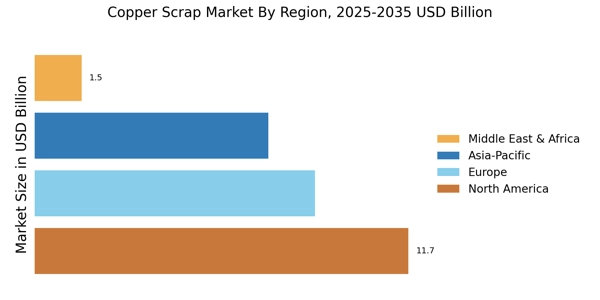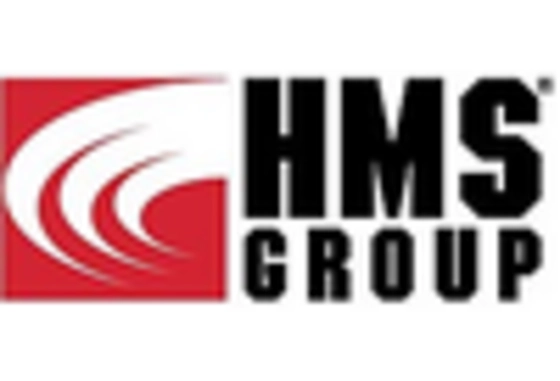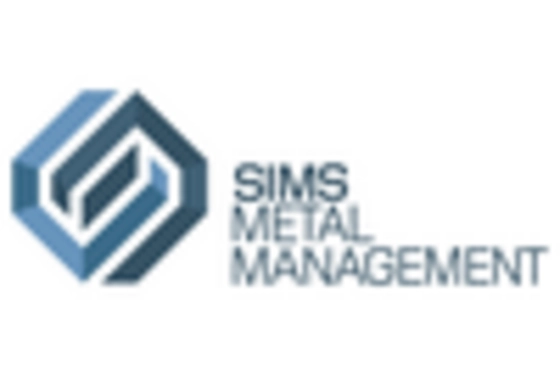Fluctuating Copper Prices
Fluctuating copper prices are a critical driver for the Copper Scrap Market. The prices of copper on the commodities market can significantly influence the demand for copper scrap, as higher prices often lead to increased collection and recycling efforts. In 2025, it is expected that copper prices will remain volatile due to various factors, including geopolitical tensions and supply chain disruptions. This volatility may encourage more businesses and individuals to sell their copper scrap, thereby boosting the supply available for recycling. Consequently, the Copper Scrap Market is likely to experience fluctuations in activity levels, closely tied to the dynamics of copper pricing, which can impact profitability and investment in recycling infrastructure.
Rising Demand for Renewable Energy
The Copper Scrap Market is experiencing a notable increase in demand due to the growing emphasis on renewable energy sources. As countries strive to meet their energy needs sustainably, the demand for copper, a critical component in renewable energy technologies such as solar panels and wind turbines, is surging. In 2025, the renewable energy sector is projected to require a substantial amount of copper, leading to a heightened need for copper scrap. This trend not only supports the recycling industry but also enhances the overall sustainability of energy production. The Copper Scrap Market is thus positioned to benefit from this shift towards greener energy solutions, as the recycling of copper scrap provides an efficient means to meet the rising demand without depleting natural resources.
Increasing Environmental Regulations
The Copper Scrap Market is being shaped by increasing environmental regulations aimed at promoting recycling and reducing waste. Governments are implementing stricter policies to encourage the recycling of metals, including copper, to minimize environmental impact. In 2025, it is anticipated that these regulations will further incentivize the collection and processing of copper scrap, as companies seek to comply with sustainability mandates. This regulatory environment not only fosters a more responsible approach to resource management but also enhances the market for recycled copper. As a result, the Copper Scrap Market is likely to expand, driven by the need for compliance and the growing recognition of the environmental benefits associated with recycling.
Infrastructure Development Initiatives
Infrastructure development initiatives across various regions are significantly influencing the Copper Scrap Market. Governments are increasingly investing in infrastructure projects, including transportation, utilities, and urban development, which require substantial amounts of copper. For instance, in 2025, it is estimated that infrastructure spending will reach unprecedented levels, driving the demand for copper scrap as a cost-effective and sustainable material. The use of recycled copper not only reduces the environmental impact associated with mining but also supports local economies by creating jobs in the recycling sector. Consequently, the Copper Scrap Market is likely to see robust growth as infrastructure projects continue to proliferate, necessitating the use of recycled materials.
Technological Innovations in Recycling
Technological innovations in recycling processes are transforming the Copper Scrap Market. Advanced sorting and processing technologies are enhancing the efficiency of copper scrap recovery, making it more economically viable. In 2025, the implementation of automated systems and artificial intelligence in recycling facilities is expected to increase the purity and yield of recycled copper. This advancement not only improves the profitability of recycling operations but also meets the stringent quality standards demanded by manufacturers. As a result, the Copper Scrap Market is poised for growth, as higher quality recycled copper becomes increasingly sought after in various applications, from electrical wiring to construction materials.


















Leave a Comment